When designing power circuits, it is often required to switch two loads at once, operating in different lines and connected alternately to the same voltage source. For these purposes, a conventional switch simply breaking the circuit is not suitable. A device with a more complex circuit is required. A well-known electrical device called the "2-way switch" copes with this task perfectly. With its help, it is possible to switch lines with a wide variety of load characteristics.
Principle of operation and device
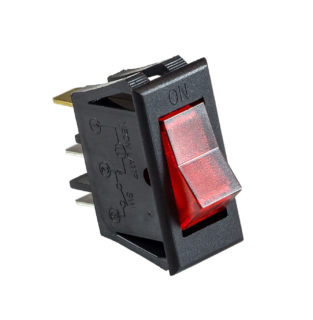
A classic two-way switch or two-position switch belongs to the same category of devices as a conventional single-pole device. However, if the latter simply closes and opens the power circuit, turning on or off the load, then the electric switch for 2 positions switches its contact from one load line to another. This is its fundamental difference from other switching elements, which naturally affects the device.
A two-pole device (in contrast to a single-pole analogue) contains in its design not two, but three groups of switched contacts. One of them, called the central one, is alternately connected to one or the other direction, supplying power to various consumers. A typical example of this design is an ordinary toggle switch, which in most equipment is used only halfway - like a switch or on-off switch. If this device uses the second direction, it turns into a changeover type device, disconnecting one load from the mains and connecting another.
According to the type of switched voltages, known samples of switches for 2 positions are divided into single-phase and three-phase models. The category of more complex structures includes products designed for several positions at once (they are called multi-position). Bipolar bi-directional switches belong to the same category.
Three-phase and two-position modular switches
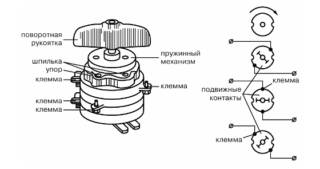
Devices of this class are installed in three-phase networks and allow switching the power supply to powerful asynchronous electric motors. In particular, they are used to switch a set of 3 windings from one switching circuit to another: from "triangle" to "star" and vice versa.
Switching modes of connecting stator windings is necessary in order to reduce the amount of inrush currents in the power supply circuits - to "facilitate" starting.
Two-position modular switches are represented in the range of electrical products by cam-type packet switches. They are widely used in the following situations:
- when installing control panels for AC and DC power equipment;
- in modern power grids equipped with automatic backup systems;
- for switching winding circuits and operating modes of electric motors, as well as for controlling lighting from several points at once;
- to select suitable conditions for the functioning of transformer substations (TS), as well as to optimize the operation of the switching equipment serving them;
- when choosing the desired mode for heating equipment and welding units.
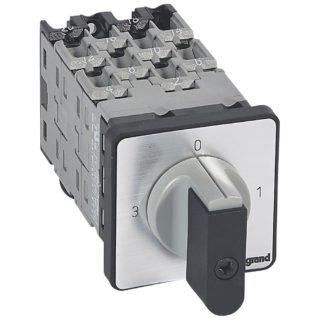
One of the varieties of two-position switches are devices that, in addition to two extreme positions, have one central one. Formally, they are referred to as three-position switches with one neutral position, but in the circuits they are still used as two-pole switches.
For the convenience of choosing the required sample of a switching product suitable for specific conditions, the main technical parameters are indicated on the case:
- type of switching device;
- rated current for which its working contacts are designed;
- electrical switching diagram (switching table);
- category of protection against climatic influences.
If there is a switching table, it will not be difficult for the operator to figure out which contact groups are triggered at the next switching.
Domestic use
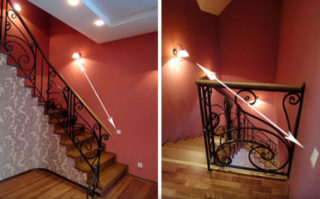
In a domestic environment, a 2-position switch is not used as often as its single-pole counterparts. But when using effective lighting systems, there are cases in which it is almost impossible to do without these switching elements. It is about organizing the control of a common light source from two or even three places in the house at once. Such a need arises in a situation when the light turns on at the entrance to a long corridor, and turns off at the exit from it. When installed at both ends of the rocker-type switches, it is not at all difficult to implement such a scheme.
Another example of the importance of controlling a lighting device from two points is when a light switch is installed at the entrance to the bedroom, and a switch is installed near the bedside table. When you press the button of the device at the entrance to the room, the group of contacts is transferred to the power line of the illuminator located in its center (chandeliers, for example). When switching the second device located by the bed, other group contacts are triggered to turn it off.
It is important to note one feature of this inclusion: the order in which each of the switches is used does not matter in principle. You can enter the corridor from either of the two ends, and turn on the light in the bedroom both from the door (when entering it) and from the bedside table. You can turn it off, respectively, both when going to bed and when leaving the room.
Another option for domestic use of two-position switching elements is possible, consisting in installing them in home lighting control circuits from three places. In this case, another switch is required, mounted in the middle of the serviced space or in any other functionally convenient place.
An additional device is switched on according to the so-called "cross" circuit, but in essence it is still the same two-pole element. With its help, it is possible to transfer group control contacts from one direction to another.
Features of installation and connection
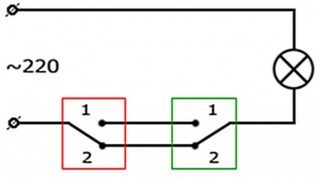
Before installing double-pole switches directly at their destination, it is important to determine the conditions for arranging wire lines at a specific facility (in a private house or apartment). In this case, there are two options for routing the harness from conductors, laid either covertly or openly. With hidden laying in the walls, special grooves (grooves) are first made, into which a corrugated hose is then placed with a set of conductors inside.
In this case, the two-pole itself will have to be placed secretly - to make a special niche in the wall for it, the size corresponding to the diameter of the fastening elements. To prepare it, you will need an electric drill with a special crown-type attachment.
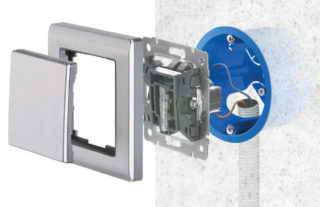
It is also necessary to prepare a plastic case or a back box in which the DIP switch will be fixed. When carrying out these operations, the following generally accepted rules are followed:
- Before starting work, completely de-energize the entire apartment or walk this branch from the switchboard by disconnecting the corresponding linear automaton.
- Prepare a rough layout of the switch and wiring to it.
- After drilling a hole of a suitable diameter in the wall, place the landing box in it, fixing it with spacer screws.
- Install the switching device itself in the finished round niche.
- Connect the appropriate conductors to its terminals and fix the case with fixing hardware.
With open installation of electrical wiring, it is possible to do without the tedious operations of preparing strobes and a special niche in the wall. In this case, the switch is fixed either directly on the wall, if its material is sufficiently dense and hard, or on a special lining made of plastic or wood, called a socket.
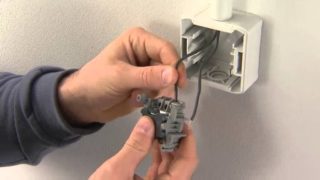
The order of installation of the open device is as follows:
- The marking of the zone of its fixation on the wall is made.
- At the selected place, an additional substrate made of wood or plastic (socket) is attached to the screws.
- The product is fixed on it by means of suitable hardware.
The procedure for connecting conductors to the terminals of the changeover device is the same as for flush-mounted installation. With this method of laying, the lead wires can be placed in a special plastic channel, called a cable channel.
The areas of application of electrical switches for two directions are not limited to the cases described. On their basis, many mechanical units are designed that control power and signal circuits.








